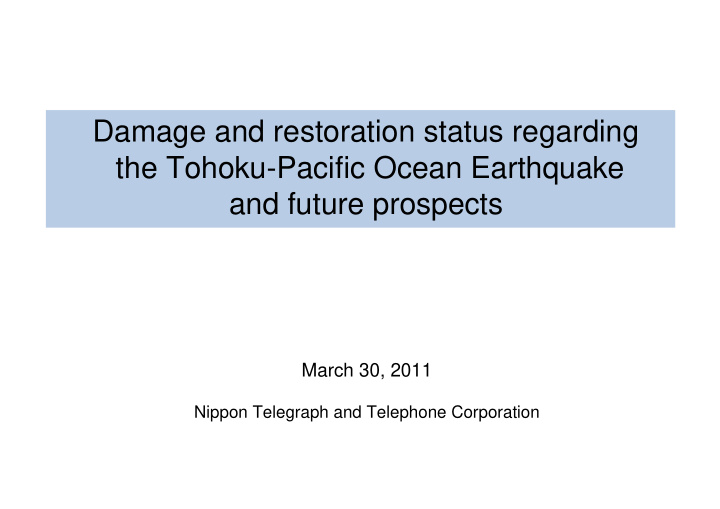



Damage and restoration status regarding the Tohoku-Pacific Ocean Earthquake and future prospects March 30, 2011 Nippon Telegraph and Telephone Corporation
Damage condition of communication facilities � Many exchange office buildings and facilities were affected by the large-scale earthquake and tsunami. � Further damage was caused due to depletion of battery capacity associated with the prolonged disruption in commercial power supply. Commercial 4 Physical damage ・ power submersion depletion of battery capacity 【 Mobile phone base station 】 DOCOMO × building × Submersion ・ 3 destruction by flood ・ Collapsed physical damage, telephone polls, 1 1 depletion of battery cable disruption capacity × × × NTT building NTT building (Exchange office (Relay building) building) DOCOMO DOCOMO Facilities, × Facilities, × × ,etc. etc. × × × Cable disruption, 2 damaged ducts 1
Restoration status of communication services � With support from all across the nation, over 10,000 people in total have been making an all-out effort to restore NTT Group’s services � Approximately 90% of exchange offices and mobile base station equipment have been restored through relief efforts by mobile power-supply vehicles and privately-owned power generators, and through facility restoration, such as by using backup relay routes. Number of affected circuits for fixed- (Unit: circuits) 1,600,000 Maximum Maximum: As of March 28, 2011 1,400,000 March 13, 2011 FLET’S Hikari Number of affected circuits line services 1,200,000 ISDN Maximum number of Approx. 112,000 Telephone subscriber lines affected circuits 1,000,000 circuits Approx. 1.5 million 800,000 (Recovery rate: 93 % ) circuits 600,000 Note: Figures exclude failures due to circuit disruptions between customer homes and NTT East exchange offices. 400,000 200,000 0 3/11 3/12 3/13 3/14 3/15 3/16 3/17 3/18 3/19 3/20 3/21 3/22 3/23 3/24 3/25 3/26 3/27 3/28 (Unit: base stations) Number of base station equipment with Maximum 7,000 Maximum: As of March 28, 2011 discontinued mobile services 6,000 March 12, 2011 Number of off-the-air 5,000 Maximum number of base station equipment 4,000 off-the-air base station Approx. 690 equipment 3,000 base stations 6,720 base (Recovery rate: 90%) 2,000 stations 1,000 0 3/11 3/12 3/13 3/14 3/15 3/16 3/17 3/18 3/19 3/20 3/21 3/22 3/23 3/24 3/25 3/26 3/27 3/28 2
Future restoration prospects � Going forward, NTT Group is planning to almost completely restore its services (except certain areas) by the end of April through renewal of power supplies and equipment in exchange offices, re-installation of relay transmission lines, further repair of base stations’ relay transmission lines, and area remedies using large zone schemes. � With regards to the remaining areas, NTT Group will primarily endeavor to restore services in local governments and evacuation centers where in focus, and also improve the communication environment by providing further more satellite mobile phones and other telecommunication means. < Fixed >< Mobile > Actions to be taken going forward: ・ Renewal of power supplies and equipment in exchange offices, re-installation of relay transmission lines ・ Repair of base stations’ relay transmission lines using emergency fiber Approx. 46 unrestored 307 disrupted Approx. optic cable and Microentrance 6,720 base buildings* 2 base stations* 2 1,000 ・ Area remedies using large zone schemes station buildings equipment max* 1 max Iwate Iwate 21 buildings 184 base Actions taken so far: stations • Relief efforts by mobile 59 disrupted base power-supply vehicles and stations* 2 privately-owned power generators (restoration of commercial power supply) Miyagi Iwate Aim to restore Miyagi • Use of backup relay routes. 97 base 47 base stations all buildings 23 buildings • Expansion of restored stations Some buildings may areas led by the recovery of Miyagi require certain parent station Fukushima 8 base stations amount of time to 26 base be restored* 2 Fukushima Fukushima 4 base stations 2 buildings stations March 28 End of April *1 Number of buildings with commercial power supply disruptions and equipment failures due to the earthquake. *2 Excluding areas surrounding Fukushima Nuclear Power Plant (9 fixed-line service buildings and 68 mobile base stations). 3
Main efforts in securing a means of communication Deployment of mobile base station vehicles (approx. 30 vehicles) Rental of free satellite mobile phones (approx. 870 handsets) , mobile phones (approx. 1,440 handsets) and tablet PCs (approx. 180 terminals) Installation of special public telephones utilizing portable satellite Securing a means equipment (approx. 2,300 telephones) of communication Implemented to accommodate all requests from local governments Installation of free Internet stations (138 stations) Provided broadband environment through tie-ups with other companies as a means to gather information through the Internet Provision of free public wireless LAN (FLET’S SPOT, etc.) Provided free of charge for affected people and volunteers Disaster Emergency Message Dial (approx. 3.17 million uses) Safety Disaster Emergency Broadband Message Board (approx. 0.24 million uses) confirmation Disaster Message Board (approx. 3.79 million uses) Provision of 43 company residences (approx. 3,000 houses) and 4 gymnasia Provided as living space for affected people upon the government’s request Life support Donation of 1 billion yen * Figures as of March 28, 2011 4
Recommend
More recommend